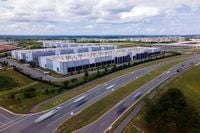Microsoft’s ambitious plan to invest more than $7 billion in two hyperscale artificial intelligence (AI) data centers in Wisconsin is drawing both applause and scrutiny, as the nation grapples with the double-edged sword of the AI boom: rapid technological progress and mounting energy costs. While the first $3.3 billion facility in Mount Pleasant is nearing completion and set to open in early 2026, with hiring already underway, a further $4 billion is earmarked for a second, similarly massive site elsewhere in the state. The company promises not only a leap forward in AI capabilities but also a commitment to sustainability and community investment. Yet, as Microsoft and other tech giants race to build these digital fortresses across the United States, the ripple effects on energy prices and local communities are increasingly hard to ignore.
According to BizClik, the Mount Pleasant data center is engineered to train advanced AI models using hundreds of thousands of NVIDIA graphics processing units (GPUs), with enough fiber optic cable connecting these GPU clusters to circle the planet four times. Microsoft claims this facility will deliver ten times the performance of today’s fastest supercomputers—a staggering leap that underscores the scale of the AI revolution. But such power comes at a cost. Data centers like these are notorious for their voracious energy appetite, and recent years have seen electricity bills soar in regions with heavy data center activity.
As reported by NBC News, leaders in states like Virginia and New Jersey—both home to significant data center clusters—are facing voter frustration as monthly electricity costs have risen by as much as 267% compared to five years ago in some areas. “Voters are mad as hell about energy prices increasing,” said Virginia state Del. Shelly Simonds, a Democrat. “And they’re mad about affordability in general. And anybody who ignores these issues does so at their peril. It’s definitely going to be an issue during the midterms.” The tension is especially acute in Virginia, considered the nation’s data center hub, and New Jersey, which has experienced some of the sharpest year-over-year hikes in utility bills.
Microsoft, aware of these concerns, is keen to position its Wisconsin project as a model of responsible innovation. The company has designed the Mount Pleasant facility with sustainability at its core, deploying a closed-loop liquid cooling system that serves over 90% of the site. This system is filled once during construction and recirculates the liquid, resulting in zero water waste. “Our data centers use advanced closed-loop liquid cooling systems,” said Noelle Walsh, President for Cloud Operations + Innovation at Microsoft. This innovation “enables higher rack density and supports the most demanding AI workloads while dramatically reducing environmental impact.” For the remaining areas of the site, outside air is used for cooling, with water only coming into play during peak heat. The total annual water usage is expected to be equivalent to that of an 18-hole golf course during a single summer week—a figure Microsoft touts as modest given the scale of operations.
On the energy front, Microsoft has committed to covering its energy needs without impacting local energy prices by pre-paying for energy and infrastructure. The company pledges to match every kilowatt-hour of fossil fuel energy consumed with carbon-free energy supplied back to the grid. A new 250MW solar project in Portage County is under construction to help fulfill this promise, and Microsoft is collaborating with WE Energies to ensure grid reliability. The company is also funding ecological restoration projects with the Root-Pike Watershed Initiative Network, aiming to offset its environmental footprint.
Yet, as NBC News highlights, the broader picture is complicated. The consulting firm Monitoring Analytics estimated that data centers account for 63% of electricity price increases for the coming year in certain regions. PJM Interconnection, which operates the grid for 13 states including New Jersey, Virginia, and Pennsylvania, reports that demand for electricity is outpacing supply, driven by data centers, AI development, and the electrification of vehicles and buildings. “The bottom line about electricity prices is that we are facing a situation of demand outpacing supply, causing prices to rise,” said Daniel Lockwood, a spokesman for PJM. The interconnected nature of the power grid means that cost increases can spill over into neighboring states, amplifying the impact.
To attract data centers, state officials have offered hefty tax breaks to companies like Meta, Microsoft, and Oracle, citing the promise of job creation and increased tax revenue. At the peak of construction in Mount Pleasant, more than 3,000 workers have been on-site, and Microsoft expects to employ around 500 full-time staff when the first facility is operational, rising to 800 with the completion of the second. Microsoft has also partnered with Gateway Technical College to establish Wisconsin’s first Datacenter Academy, aiming to train over 1,000 students for data center roles within five years.
However, some lawmakers remain skeptical about the long-term benefits for local residents. “I don’t care what anybody says, data centers don’t produce jobs,” said Virginia state Sen. Richard Stuart, a Republican, noting that while construction and maintenance jobs are created, the number of permanent positions is limited compared to the scale of the investment. “They’re just large boxes that create cash value,” echoed Virginia state Del. Josh Thomas, a Democrat. “They do create jobs during the construction process, and there are a few maintenance jobs that certainly will provide a generation’s worth of work for a few people, but they’re not job creators, the way other industries are that would take up that footprint.”
Legislative efforts are underway in several states to ensure data centers pay a fairer share of the costs associated with the infrastructure upgrades they necessitate. In New Jersey, Assemblywoman Andrea Katz introduced a bill to create a data center surcharge aimed at modernizing the state’s electric grid. “Our grid needs a lot of improvements, and those improvements are very, very expensive,” she said. “I’m not saying remove these data centers. They just need to contribute to the community in the same way that all the other businesses do.”
The debate has spilled into the political arena, with candidates in the 2025 gubernatorial races in Virginia and New Jersey making data center energy costs a campaign issue. Virginia’s Democratic nominee, former Rep. Abigail Spanberger, has called for “making sure data centers don’t drive up energy costs for everyone else in Virginia—including by paying their fair share of the cost of new electricity generation and transmission.” Her Republican opponent, Lt. Gov. Winsome Earle-Sears, has instead pointed to Democratic-backed clean energy policies as the main culprit behind rising bills. In New Jersey, Democratic nominee Rep. Mikie Sherrill has pledged to declare a “state of emergency” on utility costs, while Republican Jack Ciattarelli has advocated for attracting more data centers and following Pennsylvania’s example of robust energy supply.
Meanwhile, public opinion on data center development is still forming, but local opposition is mounting. In Virginia, an unusual coalition of farmers, environmentalists, and rural residents is demanding answers about the impact of these facilities. “They’re not trying to build a fence and a gate, but they want answers,” said Sen. Stuart. The data center industry, for its part, insists it is committed to paying its full cost of service for the energy it uses, including transmission, and stands ready to work with policymakers to ensure a reliable and affordable grid.
As Microsoft’s Mount Pleasant facility nears completion, the company’s Vice Chair and President Brad Smith—himself a Wisconsin native—frames the project as a turning point for the region. “Mount Pleasant isn’t just becoming a hub for AI—it’s becoming a blueprint for how innovation can serve everyone. We’re not just investing in an AI data center; we are investing in a community.”
With the stakes rising on both sides of the energy equation, Wisconsin’s data center experiment is shaping up to be a test case for the nation: Can the promise of AI-driven innovation be squared with the realities of energy costs and community impact? Only time will tell if this blueprint can truly serve everyone.

